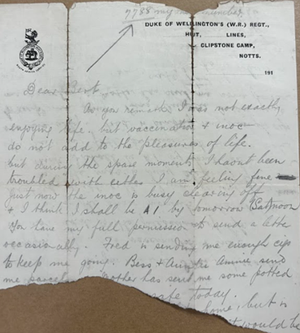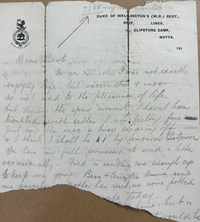
Brothers at War: Frank Arthur Brown
Frank Arthur Brown was born to Richard and Anne Brown, one of seven siblings and one of four brothers to participate in the First World War. His eldest brother Robert was the owner of R. B. Brown and Sons, a textiles mill located in Hebden Bridge. His older brother Fred was part of the Labour Corps, while Tom was a member of the West Yorkshire Regiment. All three brothers worked within the family business: before the war Frank was a clothier, while Robert owned the business and Fred managed it. During his time at war, Frank sent many letters to his brother Bert (Robert), constantly asking about the wellbeing of his siblings and wife, Elizabeth, and how the family business was fairing. Frank's letters are dated from July 1917 to December 1918 and highlight what life was like in the 2/4 Duke of Wellington (West Riding) Regiment, as well as his own experience of getting medical treatment in France.

The 2/4 Duke of Wellington regiment was a part of the Territorial Force established under the Territorial and Reserves Force Act, 1907. During the First World War, the Territorial Force was set up to function as defence for the home front while the main portion of the British Army was away fighting in Europe. During Frank’s time with the 2/4 Duke of Wellington regiment it underwent a name change, alternating between the Duke of Wellington regiment and the Yorkshire West Riding regiment. This resulted in Frank having to update his brother on the new postal address numerous times.
His regiment was not stationed in just one location but moved around the south of England and France, spending the later years of the war in field hospitals. He rose through the ranks and by March of 1918 he was promoted to Lieutenant, writing to his brother about his promotion on 6th March 1918:
After arriving safely and landing to the batt… I settled down into my old position of 2nd commd. Which I look upon as a slice of luck for me.
His brother Fred commented on Frank’s military success in his own letters to Bert saying:
Wonder how Frank fancies himself as a sort of junior Napoleon, hope he ishaving a good time anyway.
Frank referred to his role as second-in-command as being a “boss,” having the responsibility to take orders from the commander and relay to the rest of the battalion. However, even though he had risen to this rank, he expressed his aspirations to become the General numerous times to his brother, but this did not end up happening.
For many months in 1917 and 1918 Frank spent periods of time in hospital for “Chronic Synovitis” and for nerve pain in right leg. He gained a lot of medical attention for his injury however he suffered from prolonged problems with his knees after the war. Chronic synovitis is a condition characterised by inflammation of the joints. A common cause for this condition is overuse or repeated trauma or injury to the joint; in Frank's case this was to his right knee. Through correspondence with his brother, Frank repeatedly expressed the pain his knee brought him and the struggles in gaining medical leave to gain treatment for the injury.
Stationed in Etaples BEF France, Frank wrote in detail about the treatment his was given for his knee, telling Bert:
I go for daily [electrotherapies] except Sundays to the Electric Therapeutic Depots for treatment. First I have a hot bath placed round my knee (electric). It doesn’t quite scrape but nearly, then a massage after which I get shocks for about 5 minutes. So far the treatment is easy and up to now doesn’t last long before the old feeling get back and I start limping again.
The use of electrotherapies to treat neurological injuries and ailments was used prior to the First World War, however there are few complete documents and reports on procedures. With most full medical reports being sourced from the Great War, these documents and procedures aided with the understanding of neurological and orthopaedic injuries and helped develop modern treatments of these conditions. This resulted in specialized hospitals and wards who focus on these kinds of injuries throughout war and influenced military medical services in the subsequent Second World War.
Despite the lack of improvement to Frank's injuries and the limited understanding of his medical conditions, he survived the war, returning to England in October 1918 writing to his brother from 1st Eastern General Hospital, Cambridge:
Please keep the holder and cigs until I come up as I expect coming shortly now.
Frank survived the war, being reunited with his wife Elizabeth in November 1918 at an officer hospital in Oakham, Rutland.